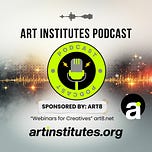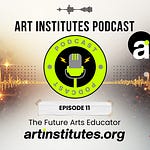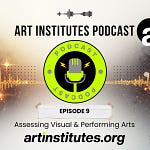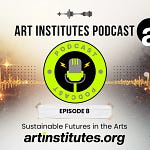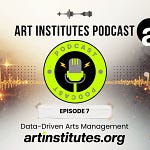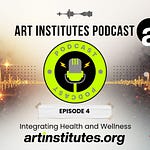Welcome to the Art Institutes Podcast, presented by Art Institutes Organization. This is the show where we celebrate the people and institutions shaping the future of art education and creative industries. Whether you're leading an art institute, teaching the next generation, or managing a cultural space, you're in the right place. So, let's get started!
In Today’s Episode: "Community as Classroom: How to Build Meaningful Partnerships for Transformative Arts Learning" Sponsored by Art8
If you’ve ever seen a student’s eyes light up because their artwork was displayed in a real gallery, or watched a shy performer gain confidence after working with a theater professional, you know something powerful happens when arts education steps outside the classroom. Today, let’s talk about how to build meaningful community partnerships—the kind that don’t just enrich your curriculum but transform how students see their own creative potential. So, Let’s dive in!
Why Community Partnerships Matter
Arts education thrives when it’s connected to the real world. Think about it: A student can learn painting techniques in a studio, but when they exhibit their work in a local gallery, suddenly they’re not just making art—they’re sharing it. They’re getting feedback from strangers, seeing how their work fits into a larger cultural conversation. That’s transformative.
And it’s not just about students. When schools partner with museums, theaters, or even local businesses, the entire community benefits. Maybe a café hangs student artwork and attracts new customers. Maybe a theater company mentors young actors and discovers fresh talent. These collaborations create a ripple effect—stronger arts ecosystems, more engaged citizens, and students who see a future for themselves in creative fields.
Finding the Right Partners
So, where do you start? Look for organizations or individuals whose values align with yours.
Galleries & Museums: Many have education programs eager for student involvement. Imagine your class collaborating on a pop-up exhibit where students curate their own show.
Working Artists: Invite a sculptor to demo techniques, or a graphic designer to critique student portfolios. These interactions make careers feel tangible.
Community Centers & Nonprofits: They often have funding or space for public art projects—like murals or installations addressing local issues.
Local Businesses: A bookstore might host student readings; a boutique could sell student-made jewelry. It’s exposure and real-world experience.
The key? Don’t just look for donors—look for collaborators who are as invested in the process as you are.
Building Partnerships That Last
One-off projects are great, but long-term relationships create deeper impact. Here’s how to nurture them:
Start with Clarity
Ask: What can we offer each other? Maybe your students bring fresh ideas; maybe the partner provides professional mentorship.
Put it in writing—even informally—so everyone’s on the same page.
Design Mutually Beneficial Projects
Example: A printmaking class partners with a coffee shop to design limited-edition packaging. Students get real briefs; the shop gets unique artwork.
Or: A theater department collaborates with a nursing home on an intergenerational storytelling project. Everyone leaves inspired.
Make It Sustainable
Secure grants or sponsorships to fund ongoing work.
Train students to document the process—blogs, videos, or presentations—so partners see the value they’re creating.
Bringing It Into the Classroom
Once you’ve got partners, integrate them naturally into your teaching:
Project-Based Learning: Have students design a real campaign for a nonprofit, or create public art with community input.
Field Work: Turn a gallery visit into a critique session with the curator. Take rehearsals to a local theater.
Mentorships: Pair students with professionals for portfolio reviews or skill-building workshops.
Proving the Impact
To keep partnerships alive, show their worth:
For Students: Track growth in technical skills, confidence, or career clarity.
For Partners: Share data—like increased foot traffic from a student exhibit—or heartfelt testimonials.
For the Community: Document how projects sparked dialogue or beautified spaces.
Making a Connection
The best arts education doesn’t just teach—it connects. So this week, ask yourself: Who’s one potential partner I could reach out to? Maybe it’s that indie gallery downtown, or the graphic designer who spoke at last year’s career day. Start small. Be clear about the mutual benefits. And watch how your classroom—and your community—starts to change.
Because when we treat the community as a classroom, we don’t just teach art. We show students how to live it.
Thanks for listening to the Art Institutes Podcast. This episode has been brought to you by Art8, “Webinars for Creatives”. Share your artistic passions, sell your art, learn new skills, and build your tribe, with Live or On-Demand expert webinars. Learn more at www.art8.net.
Here's how to stay connected to Art Institutes. First, subscribe to the Art Institutes podcast so you never miss an episode. Next, sign up for our popular newsletter at news.artinstitutes.org.
Together, we're not just supporting the art world, we're redefining it. Thanks for tuning in to the Art Institutes Podcast. Remember, art doesn't just happen. It's foundation is built by institutions and individuals like you. So keep creating, keep leading, and we'll see you next time on the Art Institutes Podcast.
Here's how to stay connected to Art Institutes. First, subscribe to the Art Institutes podcast so you never miss an episode. Next, sign up for our popular newsletter at news.artinstitutes.org.
Together, we're not just supporting the art world, we're redefining it. Thanks for tuning in to the Art Institutes Podcast. Remember, art doesn't just happen. It's foundation is built by institutions and individuals like you. So keep creating, keep leading, and we'll see you next time on the Art Institutes Podcast.


